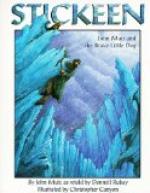Beginning, not immediately above the sunken end of the bridge, but a little to one side, I cut a deep hollow on the brink for my knees to rest in. Then, leaning over, with my short-handled axe I cut a step sixteen or eighteen inches below, which on account of the sheerness of the wall was necessarily shallow. That step, however, was well made; its floor sloped slightly inward and formed a good hold for my heels. Then, slipping cautiously upon it, and crouching as low as possible, with my left side toward the wall, I steadied myself against the wind with my left hand in a slight notch, while with the right I cut other similar steps and notches in succession, guarding against losing balance by glinting of the axe, or by wind-gusts, for life and death were in every stroke and in the niceness of finish of every foothold.
After the end of the bridge was reached I chipped it down until I had made a level platform six or eight inches wide, and it was a trying thing to poise on this little slippery platform while bending over to get safely astride of the sliver. Crossing was then comparatively easy by chipping off the sharp edge with short, careful strokes, and hitching forward an inch or two at a time, keeping my balance with my knees pressed against the sides. The tremendous abyss on either hand I studiously ignored. To me the edge of that blue sliver was then all the world. But the most trying part of the adventure, after working my way across inch by inch and chipping another small platform, was to rise from the safe position astride and to cut a step-ladder in the nearly vertical face of the wall,—chipping, climbing, holding on with feet and fingers in mere notches. At such times one’s whole body is eye, and common skill and fortitude are replaced by power beyond our call or knowledge. Never before had I been so long under deadly strain. How I got up that cliff




